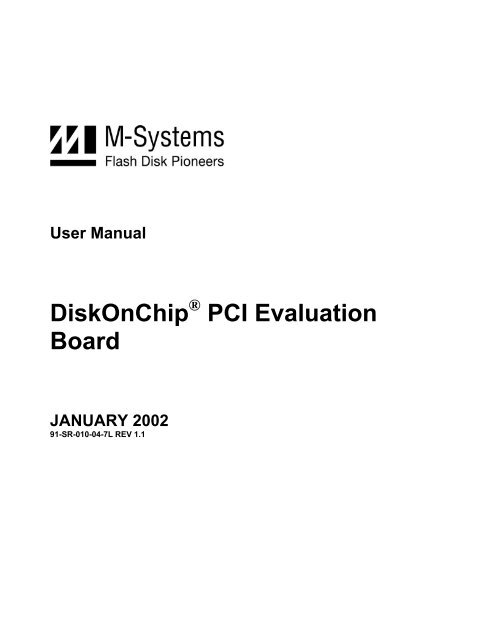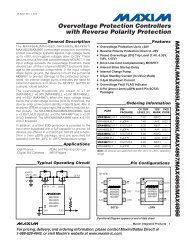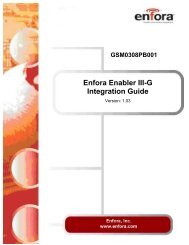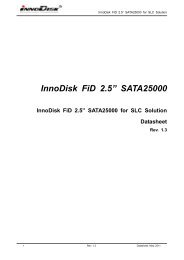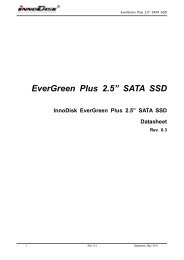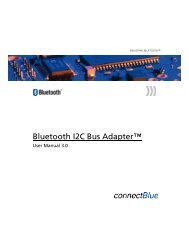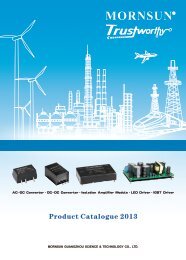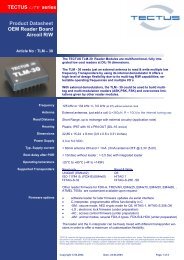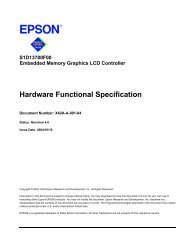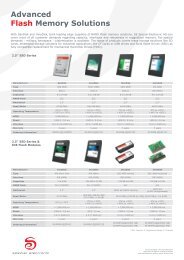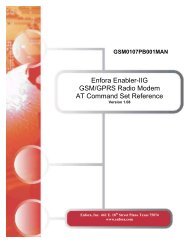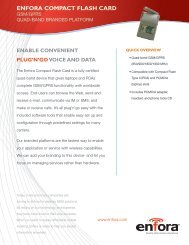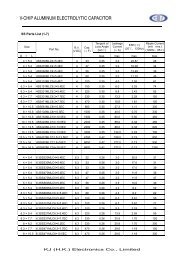User Manual: DiskOnChip PCI Evaluation Board
User Manual: DiskOnChip PCI Evaluation Board
User Manual: DiskOnChip PCI Evaluation Board
You also want an ePaper? Increase the reach of your titles
YUMPU automatically turns print PDFs into web optimized ePapers that Google loves.
<strong>User</strong> <strong>Manual</strong><br />
<strong>DiskOnChip</strong> ® <strong>PCI</strong> <strong>Evaluation</strong><br />
<strong>Board</strong><br />
JANUARY 2002<br />
91-SR-010-04-7L REV 1.1
Table of Contents<br />
<strong>DiskOnChip</strong> <strong>PCI</strong> EVB <strong>User</strong> <strong>Manual</strong><br />
1 Introduction................................................................................................................................ 3<br />
1.1 Supported Devices ...............................................................................................................3<br />
1.2 Features ............................................................................................................................... 4<br />
2 <strong>DiskOnChip</strong> <strong>PCI</strong> EVB Package Contents................................................................................. 4<br />
3 System Requirements ............................................................................................................... 4<br />
4 <strong>DiskOnChip</strong> <strong>PCI</strong> EVB <strong>Board</strong> Contents ..................................................................................... 5<br />
4.1 Determining the Base Address............................................................................................. 5<br />
4.2 Selecting the Voltage ...........................................................................................................5<br />
4.3 Locking Protected Areas ...................................................................................................... 6<br />
4.4 Working in 16-Bit Mode ........................................................................................................ 6<br />
4.5 Disabling TSOP Devices Soldered On-<strong>Board</strong> ...................................................................... 6<br />
5 Installing and Configuring the <strong>DiskOnChip</strong> <strong>PCI</strong> EVB ............................................................. 7<br />
5.1 Installing <strong>DiskOnChip</strong> as an Additional Disk Drive ............................................................... 7<br />
5.2 Using the <strong>DiskOnChip</strong> EVB as a Boot Device (DOS Example)............................................ 7<br />
5.3 Identifying <strong>DiskOnChip</strong> in the EVB....................................................................................... 8<br />
5.4 Reformatting <strong>DiskOnChip</strong>..................................................................................................... 8<br />
6 Additional Software Utilities for the <strong>DiskOnChip</strong> <strong>PCI</strong> EVB .................................................... 8<br />
6.1 Using PMC Connectors........................................................................................................ 8<br />
7 Order Information ...................................................................................................................... 9<br />
8 Troubleshooting....................................................................................................................... 10<br />
How to Contact Us .......................................................................................................................... 12<br />
91-SR-010-04-7L Rev 1.1 2
1 Introduction<br />
<strong>DiskOnChip</strong> <strong>PCI</strong> EVB <strong>User</strong> <strong>Manual</strong><br />
The <strong>DiskOnChip</strong> <strong>PCI</strong> <strong>Evaluation</strong> <strong>Board</strong> (EVB) provides a quick, easy way to evaluate the<br />
<strong>DiskOnChip</strong> in platforms with a <strong>PCI</strong> extension slot. The EVB is a useful tool for designers who need<br />
to evaluate, program, duplicate or test the <strong>DiskOnChip</strong>, even before their target platform is available.<br />
Once installed, the <strong>DiskOnChip</strong> <strong>PCI</strong> EVB can be accessed as an additional disk drive or as a boot<br />
device.<br />
M-Systems’ <strong>DiskOnChip</strong> products are high-performance, single-chip flash disks that provide full<br />
hard drive emulation for all major operating systems and platforms. This unique product line offers a<br />
complete data storage solution for applications in which mechanical hard drives cannot be used, such<br />
as embedded systems, Internet access devices, network computers and mobile systems. <strong>DiskOnChip</strong><br />
Millennium Plus provides superior performance through a true 16-bit bus interface, and offers<br />
security-enabling and data-protection features.<br />
1.1 Supported Devices<br />
The <strong>DiskOnChip</strong> <strong>PCI</strong> EVB supports the entire <strong>DiskOnChip</strong> product line, including:<br />
• <strong>DiskOnChip</strong> Millennium Plus: 48-pin TSOP-I single-chip flash disk. Available capacity:<br />
32MB. Features a true 16-bit data bus, data read/write protection and security-enabling<br />
capabilities, 1KB XIP boot block and a ROM-like One Time Programming area (OTP).<br />
• Mobile <strong>DiskOnChip</strong>: 63-ball BGA single-chip flash disk. Available capacity: 16MB. Includes a<br />
1KB XIP boot block.<br />
• <strong>DiskOnChip</strong> 2000 TSOP: 48-pin TSOP-I single-chip flash disk. Available capacity: 16MB.<br />
Includes a 1KB XIP boot block.<br />
Note: Software utilities and driver version 5.0 and higher are required for all above devices.<br />
• <strong>DiskOnChip</strong> Millennium: 32-pin DIP or 32-pin TSOP-II single-chip flash disk. Available<br />
capacity: 8MB. Includes a 512-byte XIP boot block.<br />
• <strong>DiskOnChip</strong> 2000: 32-pin DIP flash disk. Available capacities: 8MB to 576MB.<br />
• <strong>DiskOnChip</strong> DIMM 2000: 144-pin Small Outline DIMM (Dual In-Line Memory Module) flash<br />
disk. Available capacities: 16MB to 256MB.<br />
A TrueFFS driver is required to work with any of the <strong>DiskOnChip</strong> products,. TrueFFS is natively<br />
supported by every major OS, such as Windows CE, Windows 2000, QNX, and VxWorks. The latest<br />
TrueFFS drivers can be obtained from M-Systems for these operating systems and others, such as<br />
DOS, Linux, pSOS and NT Embedded. For other environments (including OS-less) the TrueFFS<br />
Software Development Kit (SDK) can be obtained. When using <strong>DiskOnChip</strong> as the boot device in a<br />
non-x86 environment, M-Systems’ Boot Software Development Kit (Boot SDK) package is required.<br />
Contact M-Systems regarding availability for both packages.<br />
91-SR-010-04-7L Rev 1.1 3
1.2 Features<br />
The <strong>DiskOnChip</strong> <strong>PCI</strong> EVB includes the following features:<br />
• Support for the current <strong>DiskOnChip</strong> product line.<br />
<strong>DiskOnChip</strong> <strong>PCI</strong> EVB <strong>User</strong> <strong>Manual</strong><br />
• An independent memory window for each device on-board. Up to four <strong>DiskOnChip</strong> form factors<br />
can be activated simultaneously on this EVB.<br />
• Support for 3.3V and 5V DIP and DIMM devices.<br />
• Support for 3.3V TSOP-I and TSOP-II products.<br />
• Variable 8-bit or 16-bit operation mode (relevant for <strong>DiskOnChip</strong> Millennium Plus).<br />
• Support for the <strong>DiskOnChip</strong> Millennium Plus hardware protection option, including the Lock#<br />
signal.<br />
• Two fixed memory base address are available for each <strong>DiskOnChip</strong> socket on board (using<br />
jumper).<br />
• Available jumpers for disabling TSOP-I and/or TSOP-II devices soldered on-board.<br />
2 <strong>DiskOnChip</strong> <strong>PCI</strong> EVB Package Contents<br />
The <strong>DiskOnChip</strong> <strong>PCI</strong> EVB package includes the following:<br />
• <strong>DiskOnChip</strong> <strong>PCI</strong> EVB<br />
Note: Five different ordering configurations are available. Verify you have received the one you ordered (refer to<br />
Table 7 on page 9).<br />
• Release Letter<br />
• Quick Installation Guide<br />
• <strong>DiskOnChip</strong> Data CD with:<br />
Software utilities and tools<br />
Additional documentation<br />
Note: It is recommended to download the latest software utilities from our website at www.m-sys.com.<br />
• M-Systems limited warranty<br />
3 System Requirements<br />
• PC or any other platform with free <strong>PCI</strong> bus slots.<br />
• 32KB free memory space (between C800 and E800).<br />
• It is recommended to have a bootable DOS diskette on hand as all software utilities included are<br />
compiled for DOS.<br />
91-SR-010-04-7L Rev 1.1 4
4 <strong>DiskOnChip</strong> <strong>PCI</strong> EVB <strong>Board</strong> Contents<br />
<strong>DiskOnChip</strong> <strong>PCI</strong> EVB <strong>User</strong> <strong>Manual</strong><br />
The <strong>DiskOnChip</strong> <strong>PCI</strong> EVB can host up to four <strong>DiskOnChip</strong> form factors (DIP, DIMM, TSOP-II and<br />
TSOP-I) simultaneously. You can also cascade up to two TSOP-II devices and up to four TSOP-I<br />
devices.<br />
Table 1: Jumpers and Indicators<br />
Item Description<br />
J1 Sets the <strong>DiskOnChip</strong> start address (<strong>DiskOnChip</strong> requires only an 8KB window)<br />
J2 Sets the data protection pin of <strong>DiskOnChip</strong> Millennium Plus (Lock#)<br />
J3 Sets <strong>DiskOnChip</strong> Millennium Plus to 8-bit or 16-bit mode (IF_CFG)<br />
J5 Sets <strong>DiskOnChip</strong> Millennium Plus (DIMM) to 8-bit or 16-bit mode (IF_CFG)<br />
J6 Select 3.3V or 5V operation in the DIP and DIMM sockets<br />
J16 Enables/Disables TSOP-II devices soldered on-board<br />
J17 Enables/Disables TSOP-I devices soldered on-board<br />
D1 <strong>DiskOnChip</strong> DIP and DIMM activity indicator (Chip Enable status)<br />
D2 <strong>DiskOnChip</strong> TSOP-I and TSOP-II activity indicator (Chip Enable status)<br />
D3 Power indicator LED<br />
4.1 Determining the Base Address<br />
The <strong>DiskOnChip</strong> <strong>PCI</strong> EVB supports up to four <strong>DiskOnChip</strong>s in parallel, each residing in a separate<br />
memory address. Table 2 defines the memory table for J1.<br />
* Default factory settings<br />
Table 2: J1 <strong>DiskOnChip</strong> Memory Table<br />
Device Type J1, pins 1 and 2 (U8) J1, pins 2 and 3 (U9)*<br />
TSOP-I C800 D000<br />
TSOP-II CA00 D200<br />
DIP CC00 D400<br />
DIMM CE00 D600<br />
4.2 Selecting the Voltage<br />
Use J6 (refer to Table 3) to determine the voltage supplied to the DIP and SODIMM sockets.<br />
Note: TSOP sockets are 3.3V only!<br />
* Default factory settings<br />
Table 3: Selecting Operating Voltage – J6<br />
Jumper Pins 1 and 2 Pins 2 and 3*<br />
J6 5V 3.3V<br />
91-SR-010-04-7L Rev 1.1 5
4.3 Locking Protected Areas<br />
<strong>DiskOnChip</strong> <strong>PCI</strong> EVB <strong>User</strong> <strong>Manual</strong><br />
When setting the Lock# pin, <strong>DiskOnChip</strong> Millennium Plus will not allow writing to write-protected<br />
areas or access to read-protected areas, even when the correct password is entered.<br />
Use J2 to set the Lock# state of <strong>DiskOnChip</strong> Millennium Plus (refer to Table 4).<br />
* Default factory settings<br />
4.4 Working in 16-Bit Mode<br />
Table 4: J2 Settings<br />
#Lock J2 State<br />
Enable SHORT<br />
Disable* N.C.<br />
When setting the IF_CFG pin, <strong>DiskOnChip</strong> Millennium Plus will work in full 16-bit mode, thus<br />
achieving approximately twice the performance. This is only applicable for the TSOP-I and the<br />
DIMM sockets.<br />
Table 5: J3 and J5 Settings<br />
Jumper State Outcome<br />
J3<br />
J5<br />
* Default factory settings<br />
SHORT TSOP-I socket will work in 8-bit mode<br />
N.C* TSOP-I socket will work in 16-bit mode<br />
SHORT* DIMM socket will work in 8-bit mode<br />
N.C DIMM socket will work in 16-bit mode<br />
4.5 Disabling TSOP Devices Soldered On-<strong>Board</strong><br />
You may use J16 and J17 to disable <strong>DiskOnChip</strong> devices soldered on-board (either TSOP-I or<br />
TSOP-II) without having to physically remove them from the board (refer to Table 6).<br />
Table 6: J16 and J17 Settings<br />
Jumper State Outcome<br />
J16 SHORT TSOP-II devices are disabled<br />
J17 SHORT TSOP-I devices are disabled<br />
* The default factory setting for J16 and J17 is N.C. (meaning the TSOP-I and TSOP-II sockets are enabled).<br />
91-SR-010-04-7L Rev 1.1 6
<strong>DiskOnChip</strong> <strong>PCI</strong> EVB <strong>User</strong> <strong>Manual</strong><br />
5 Installing and Configuring the <strong>DiskOnChip</strong> <strong>PCI</strong> EVB<br />
When installing the <strong>DiskOnChip</strong> <strong>PCI</strong> EVB as a bootable drive in operating systems other then DOS,<br />
make sure to place the relevant systems files on <strong>DiskOnChip</strong> (i.e., execute according to Section 5.1,<br />
then install the systems files and continue with Section 5.2).<br />
In Windows systems, the New hardware found message is displayed each time you boot with the<br />
<strong>PCI</strong> board plugged in. To suppress this message, select the option to install a driver, then select the<br />
DOC_<strong>PCI</strong>.INF file located in the <strong>PCI</strong>_EVB directory of the <strong>DiskOnChip</strong> software utilities. This will<br />
NOT install a driver, but will inform Windows of the new hardware and prevent the message from<br />
being displayed during boot-up.<br />
When working with the EVB in environments other then PC, you must use the <strong>DiskOnChip</strong> Boot<br />
SDK to enable your boot code to access <strong>DiskOnChip</strong> and load your OS and drivers.<br />
Additional information, scenarios and advice regarding using <strong>DiskOnChip</strong> as a bootable drive is<br />
available in the <strong>DiskOnChip</strong> Software Utilities <strong>User</strong> <strong>Manual</strong>.<br />
5.1 Installing <strong>DiskOnChip</strong> as an Additional Disk Drive<br />
DOS Example<br />
1. Mount <strong>DiskOnChip</strong>(s) on the EVB in the appropriate socket (SODIMM, DIP, TSOP).<br />
2. Insert the EVB into a free <strong>PCI</strong> slot (make sure your host is powered OFF).<br />
3. Power ON your computer (host).<br />
Note: TSOP devices require formatting before proceeding to step 4 (refer to the <strong>DiskOnChip</strong> Software Utilities<br />
<strong>Manual</strong> on our website).<br />
You may now access the EVB as an additional drive. When using other operating systems you may<br />
need to first install the <strong>DiskOnChip</strong> driver (see the <strong>DiskOnChip</strong> OS-specific installation manuals).<br />
5.2 Using the <strong>DiskOnChip</strong> EVB as a Boot Device (DOS Example)<br />
The <strong>DiskOnChip</strong> EVB may be used either as an additional hard drive or as the system’s boot device<br />
(drive [C:]). When shipped, <strong>DiskOnChip</strong> default settings cause it to be installed as the next available<br />
drive. This will typically be drive [D:] if the system already includes another drive. To convert it into<br />
a bootable DOS drive, perform the following:<br />
1. Boot the system and ensure that the <strong>DiskOnChip</strong> EVB is correctly installed as an additional<br />
drive.<br />
2. Copy your system files onto the <strong>DiskOnChip</strong> by typing FORMAT D: /S or SYS D: (assuming<br />
<strong>DiskOnChip</strong> is registered as drive [D:]).<br />
3. Remove your hard drive or type DFORMAT D: (or /WIN:segment) /FIRST /S:DOCnn.EXB<br />
/UPDATE. Observe the following rules:<br />
• The /S flag must be used when the /FIRST flag is used. DOCnn.EXB stands for the<br />
<strong>DiskOnChip</strong> firmware file name.<br />
• The /UPDATE flag instructs DFORMAT to update the firmware without reformatting the<br />
flash media, keeping the information on it intact (such as the DOS systems files).<br />
4. Reboot the system. After rebooting, the <strong>DiskOnChip</strong> is identified as drive [C:].<br />
91-SR-010-04-7L Rev 1.1 7
5.3 Identifying <strong>DiskOnChip</strong> in the EVB<br />
<strong>DiskOnChip</strong> <strong>PCI</strong> EVB <strong>User</strong> <strong>Manual</strong><br />
There are two utilities that can identify the <strong>DiskOnChip</strong> unit mounted on the EVB. You can use<br />
DINFO when the drivers are correctly loaded (indicated by the sign-on messages display). If the<br />
messages were not displayed, use DINFO/DIRECT to search for <strong>DiskOnChip</strong>.<br />
DINFO provides information regarding <strong>DiskOnChip</strong> size, amount of physical flash used, number of<br />
flash devices inside <strong>DiskOnChip</strong>, drive letter occupied by <strong>DiskOnChip</strong>, firmware version, and so on.<br />
5.4 Reformatting <strong>DiskOnChip</strong><br />
Warning: Running DFORMAT erases all data from <strong>DiskOnChip</strong>. Make sure to back up your data<br />
before using this utility.<br />
<strong>DiskOnChip</strong> can be reformatted on-board using the DFORMAT utility. The DFORMAT utility can<br />
be used whether or not the device was recognized by the system and assigned a drive letter.<br />
Assuming <strong>DiskOnChip</strong> is located at address 0xC800, the format command is:<br />
DFORMAT /WIN:C800 /other flags<br />
After running DFORMAT, you must reset the system to allow the changes to take effect.<br />
Important: Correct initialization of your <strong>DiskOnChip</strong> must be performed before starting<br />
development. It is highly recommended to thoroughly read the <strong>DiskOnChip</strong> Software Utilities<br />
<strong>Manual</strong> in general, and specifically the chapter discussing DFORMAT.<br />
6 Additional Software Utilities for the <strong>DiskOnChip</strong> <strong>PCI</strong> EVB<br />
You can use any of the <strong>DiskOnChip</strong> DOS utilities with the <strong>DiskOnChip</strong> <strong>PCI</strong> EVB. Detailed<br />
information can be found in the <strong>DiskOnChip</strong> Utilities <strong>User</strong> <strong>Manual</strong>.<br />
6.1 Using PMC Connectors<br />
You can connect this EVB to boards in which the <strong>PCI</strong> bus is only accessible through PMC<br />
connectors (such as the MCP750 reference board), by using PMC to <strong>PCI</strong> adapter cards (vendor<br />
supplied). Additional information and links to these products is available on our website (www.msys.com,<br />
“Third Party Tools” located in the <strong>DiskOnChip</strong> section).<br />
91-SR-010-04-7L Rev 1.1 8
7 Order Information<br />
<strong>DiskOnChip</strong> <strong>PCI</strong> EVB <strong>User</strong> <strong>Manual</strong><br />
The <strong>DiskOnChip</strong> <strong>PCI</strong> EVB can be ordered in various configurations, depending on the <strong>DiskOnChip</strong><br />
unit to be evaluated. Refer to Table 7 as an aid in deciding which configuration you should order for<br />
your system. Note that the DIP and SODIMM sockets are available in all configurations.<br />
Ordering Info Remarks<br />
Table 7: Ordering Information<br />
DOC-DIP-DIMM-EVB-<strong>PCI</strong> Only DIP and SODIMM sockets are<br />
available on-board.<br />
DOCM8-TSOP-II-EVB-<strong>PCI</strong> The 8MB TSOP-II <strong>DiskOnChip</strong><br />
Millennium is soldered on-board and is<br />
included in the price of the package.<br />
DOC2000-TSOP-I-EVB-<strong>PCI</strong> The 16MB <strong>DiskOnChip</strong> 2000 TSOP-I is<br />
soldered on-board and is included in<br />
the price of the package.<br />
DOC-TSOP-I-EVB-<strong>PCI</strong>-ZIF TSOP-I ZIF socket plus the DIP and<br />
SODIMM sockets make this board<br />
ideal for easy evaluation of any<br />
<strong>DiskOnChip</strong>.<br />
DOCM32-TSOP-I-EVB-<strong>PCI</strong> The 32MB TSOP-I <strong>DiskOnChip</strong><br />
Millennium Plus is soldered on-board<br />
and is included in the price of the<br />
package.<br />
<strong>DiskOnChip</strong> Products Supported<br />
2000<br />
DIP<br />
2000<br />
DIMM<br />
<br />
Millennium<br />
TSOP-II<br />
<br />
2000<br />
TSOP<br />
<br />
Millennium<br />
Plus<br />
TSOP-I<br />
<br />
<br />
91-SR-010-04-7L Rev 1.1 9
8 Troubleshooting<br />
Item Action<br />
The EVB is not recognized.<br />
I can't boot from the EVB.<br />
Make sure <strong>DiskOnChip</strong> is formatted.<br />
<strong>DiskOnChip</strong> <strong>PCI</strong> EVB <strong>User</strong> <strong>Manual</strong><br />
Another device may be using the same memory window.<br />
Remove unnecessary cards and check your BIOS configuration.<br />
Another device may be using the same memory window.<br />
Change the base memory address of the <strong>DiskOnChip</strong> using J1.<br />
Are you working with the EVB in Dell, Gateway, or Compaq<br />
machines? The BIOS in all of these machines reserves all<br />
legacy ISA resource for use by <strong>PCI</strong> cards. Please use a different<br />
machine.<br />
Many BIOSs try to reserve the legacy ISA resource for use by<br />
<strong>PCI</strong> cards. Changing the BIOS settings can modify this<br />
behavior. Look for a setting that describes “Shared ISA Memory<br />
Space” and ensure that this option is set to enable the<br />
<strong>DiskOnChip</strong> window in the base address set with JP1.<br />
The <strong>DiskOnChip</strong> firmware may need to be trimmed to work with<br />
your BIOS. Please refer to the <strong>DiskOnChip</strong> software tools<br />
manual and read about the various firmware flags in DFORMAT.<br />
Ensure that pin 1 of <strong>DiskOnChip</strong> is aligned with Pin 1 pad on the<br />
board. Reverse insertion will render the <strong>DiskOnChip</strong> unusable.<br />
Are you working with an 8-bit device in 16-bit mode bus? Check<br />
the J3 and J5 settings.<br />
Is the driver loaded? When using OSs other then DOS, follow<br />
the <strong>DiskOnChip</strong> installation instructions for your specific OS.<br />
When working with the EVB in non-PC architectures, you must<br />
use the <strong>DiskOnChip</strong> Boot SDK (also known as BDK) to enable<br />
your boot code to identify <strong>DiskOnChip</strong> and load its driver.<br />
Your system may have a reset signal that is shorter than the<br />
standard reset signal defined in the <strong>PCI</strong> design specifications.<br />
The <strong>DiskOnChip</strong> <strong>PCI</strong> EVB is not recognized by these systems.<br />
Make sure you have placed the OS system files on <strong>DiskOnChip</strong><br />
(In DOS – Format D: /s).<br />
When working with the EVB in non-PC architectures, you must<br />
use the <strong>DiskOnChip</strong> Boot SDK (also known as BDK) to enable<br />
your boot code to load your OS directly from <strong>DiskOnChip</strong>.<br />
91-SR-010-04-7L Rev 1.1 10
Item Action<br />
I want to disable TSOP devices<br />
soldered on-board without<br />
removing them.<br />
How do I suppress the “Found<br />
new hardware” message in<br />
Windows?<br />
Where can I access additional<br />
tools and information?<br />
<strong>DiskOnChip</strong> <strong>PCI</strong> EVB <strong>User</strong> <strong>Manual</strong><br />
Use J16 and J17 to disable any TSOP-I and TSOP-II<br />
devices soldered on-board the EVB.<br />
When the message is displayed, select the option to install<br />
a driver, then select the DOC_<strong>PCI</strong>.INF file included with<br />
the <strong>DiskOnChip</strong> software utilities package, under the<br />
<strong>PCI</strong>_EVB directory. This will not install a driver but will<br />
suppress the message.<br />
<strong>DiskOnChip</strong> software accessories (including DFORMAT,<br />
DINFO, PUT/GET IMAGE etc.), along with other extensive<br />
<strong>DiskOnChip</strong> documentation, can be found in the enclosed<br />
CD.<br />
91-SR-010-04-7L Rev 1.1 11
How to Contact Us<br />
Internet:<br />
E-mail:<br />
USA Office:<br />
M-Systems Inc.<br />
8371 Central Ave, Suite A<br />
Newark CA 94560<br />
Phone: +1-510-494-2090<br />
Fax: +1-510-494-5545<br />
Taiwan Office:<br />
Room B, 13 F, No. 133 Sec. 3<br />
Min Sheng East Road<br />
Taipei, Taiwan<br />
R.O.C.<br />
Tel: +886-2-8770-6226<br />
Fax: +886-2-8770-6295<br />
Japan Office:<br />
M-Systems Japan Inc.<br />
Arakyu Bldg., 5F<br />
2-19-2 Nishi-Gotanda Shinagawa-ku<br />
Tokyo 141-0031<br />
Phone: +81-3-5437-5739<br />
Fax: +81-3-5437-5759<br />
http://www.m-sys.com<br />
info@m-sys.com<br />
<strong>DiskOnChip</strong> <strong>PCI</strong> EVB <strong>User</strong> <strong>Manual</strong><br />
China Office:<br />
25A International Business Commercial Bldg.<br />
Nanhu Rd., Lou Hu District<br />
Shenzhen, China 518001<br />
Phone: +86-755-519-4732<br />
Fax: +86-755-519-4729<br />
Europe & Israel Office:<br />
M-Systems Ltd.<br />
7 Atir Yeda St.<br />
Kfar Saba 44425, Israel<br />
Tel: +972-9-764-5000<br />
Fax: +972-3-548-8666<br />
M-Systems assumes no responsibility for the use of the material described in this document.<br />
Information contained herein supersedes previously published specifications on this device from<br />
M-Systems. M-Systems reserves the right to change this document without notice.<br />
91-SR-010-04-7L Rev 1.1 12


